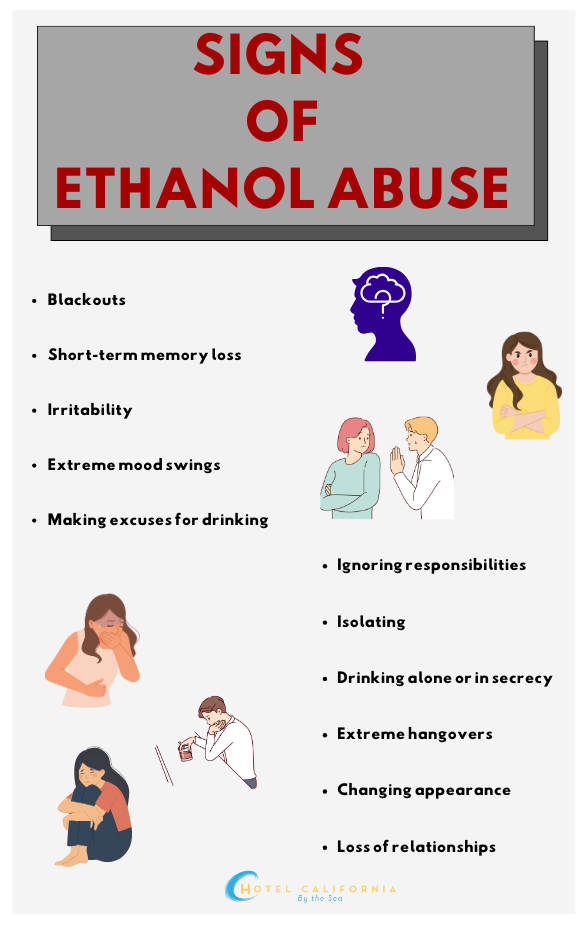What is Ethanol Abuse?
Ethyl alcohol, ethanol or ETOH, is one of the most commonly abused substances worldwide. Ethanol is the primary ingredient in alcoholic drinks and is a powerful central nervous system depressant. Ethanol abuse is most commonly referred to as alcohol abuse or alcohol use disorder (AUD). Most consider, ethanol abuse to be a milder form of alcohol use disorder. It is a mental health condition in which a person continues to drink excessively despite repeated harmful effects on their social, mental, physical and emotional health. Ethanol abuse and addiction occur when a person consumes alcohol over a long period of time.

ETOH abuse is a serious problem that affects millions worldwide. According to the World Health Organization (WHO), harmful and dangerous use of alcohol is responsible for an estimated 3 million deaths yearly. That accumulates to about 5.3% of the population worldwide. In the United States, alcohol abuse is the third leading preventable cause of death with an estimated 14 million adults diagnosed with alcohol use disorder, according to data from the Centers for Disease Control and Prevention (CDC).
What is Ethanol?
ETOH often refers to alcoholic beverages such as beer, wine, liquor and spirits. Beer is made from grain, hops, yeast and water. In the U.S., the alcohol content in beer ranges from 3-6%. The alcohol content in wine ranges from 9-14%. Liquors and spirits usually contain the highest concentration of alcohol. A 2014 report from the WHO also found that spirits were the second most popular form of alcohol in the U.S.
Alcohol is created when yeast reacts with sugars to produce carbon dioxide and ethanol. Some alcohols contain a purer concentration of ETOH. For example, moonshine contains one of the highest, if not the highest proof of ethanol. Drinking pure ethanol is highly dangerous because it can contain other harmful chemicals and it can rapidly raise blood alcohol concentration levels. Alcohol is also high in calories so it can take longer to absorb into the bloodstream, which means it can stay in the system for much longer. Once alcohol enters the bloodstream, ethanol is carried throughout the entirety of the body. ETOH can significantly impact many different organs in the body including the brain.

Ethanol Misuse vs Ethanol Abuse
Ethanol abuse often starts as alcohol misuse. It is described as excessive and daily alcohol consumption that can put a person at increased risk for harmful health and social consequences. According to the CDC, alcohol misuse in women is measured by one or more drinks per day on average. In men, more than 2 drinks per day on average are considered alcohol misuse. Misuse often turns into abuse.
Ethanol abuse is a mild form of alcohol use disorder. There are three subtypes of alcohol use disorder: mild, moderate and severe. According to the DSM, there are 11 primary symptoms that define having an alcohol use disorder. If a person has around 2-3 symptoms, they are considered a mild case of AUD. If a person has 4 symptoms, they are considered a moderate case of AUD. And if a person shows signs of 6 or more symptoms, they have a severe case of AUD.
Binge drinking is a common form of ethanol abuse and is most commonly seen in the younger population. Binge drinking has become a huge public crisis issue in the U.S. According to the National Institute on Alcohol Abuse and Alcoholism (NIAAA), an estimated 1 in 6 adults in the U.S. engage in binge drinking with young adults most likely to engage in the drinking behavior. According to the CDC, binge drinking is 4 or more drinks for women during a single occasion and 5 or more drinks for men on a single occasion. This is also known as excessive drinking. Other examples of ethanol abuse include driving while drunk, underage drinking and drinking more and longer than intended.
Check Your Insurance Coverage for FREE
Find out if your insurance covers addiction treatment in minutes. We accept most insurance!
Symptoms and Side Effects of Ethanol Abuse
- Blacking out after drinking
- Difficulty concentrating
- Difficulty controlling body movements
- Slurred speech
- Memory gaps
- Difficulty with decision-making
- Slowed reflexes and impaired balance
- Brain damage – Ethanol can permanently affect and alter brain structure leading to extreme mood swings, learning difficulties, decreased decision-making abilities and other neurological disorders.
- Heart disease – Ethanol can damage the heart by weakening its muscles leading to increased blood pressure, heart attack and stroke.
- Cancer – Ethanol has been linked directly to the development of cancers in the liver, throat, mouth and pancreas.
- Liver damage – Ethanol is processed in the liver and can cause irreversible damage such as fatty liver disease and liver cirrhosis. Constant exposure to ethanol can contribute to the build-up of acetaldehyde and result in liver cirrhosis.
- Gastrointestinal damage – Ethanol abuse can lead to stomach ulcers, inflammation of the stomach lining and damage to the esophagus.
- Pancreatic inflammation – Ethanol abuse changes the insulin production in the body and increases the risk of developing diabetes.
- Immune system suppression – Ethanol abuse inhibits the immune response and makes it more difficult for the body to defend itself against the harmful substances it is being exposed to.
- Social and legal issues can develop
- Mental health conditions such as anxiety and depression
- Drowsiness – Ethanol interferes with chemical reactions in the brain that are needed to stay awake and active.
- Obesity – Ethanol can slow down a person’s metabolism, which can lead to a slower time processing other substances like food and can lead to weight gain over time and obesity.
- Dehydration – Ethanol is a diuretic.
- Nausea and vomiting – The human body is not designed to process large amounts of alcohol. This means, it will attempt to reject as much ethanol as it possibly can, which will lead to symptoms of intense nausea and vomiting.
Why do people abuse Alcohol?
There are many reasons why people have turned to ETOH and abused alcohol. Some people use the substance as a form of self-medication to treat symptoms of mental health disorders such as anxiety, depression, PTSD and bipolar disorder. There are others who drink alcohol out of peer pressure and social pressure. This is often the case in students and young adults. And in some cases, pure boredom is the reason for turning to ETOH and developing tolerance, dependence and addiction. Some people like the way it helps to “loosen them up” or reduce feelings of self-consciousness as the drug helps to reduce inhibitions.
Reach out to Hotel California by the Sea
We specialize in treating addiction and other co-occurring disorders, such as PTSD. Our Admissions specialists are available to walk you through the best options for treating your addiction.
Do you suffer from Ethanol Abuse?
Ethanol abuse can cause both physical and psychological issues that significantly impair a person’s overall well-being. ETOH and alcohol abuse is a chronic disease and is often associated with experiencing loss of control, high alcohol tolerance and alcohol withdrawal symptoms. It has become so prevalent, that more than 700,000 Americans receive AUD treatment every day. AUD can range from mild to severe with the most effective way to treat it is through a behavioral health treatment program.
Hotel California by the Sea provides specialized clinical care for those suffering from substance use disorder, alcohol use disorder and co-occurring mental health disorders. We offer all levels of treatment care that include alcohol detox, inpatient residential treatment, partial hospitalization program and intensive outpatient program. We utilize evidence-based proven treatment methods such as cognitive behavioral therapy, dialectical behavioral therapy, group therapy and family therapy. Hotel California by the Sea recognizes the difficulties of sobriety and works with clients through every aspect of their recovery journey to help them overcome their addictions.
References:
https://www.verywellmind.com/what-is-etoh-abuse-5496755
https://www.drugrehab.com/addiction/alcohol/etoh-abuse
https://zinniahealth.com/substance-use/ethanol
https://www.recoveryteam.org/ethanol-abuse-understanding-the-problem/
https://alcoholrehabhelp.org/resources/etoh/
